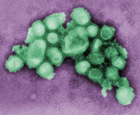|
MMWR Publications |
|
|
|
MMWR Information |
|
|
|
Additional Resources |
|
|
|

|
|
Updated
|
|

|
|
This Week in MMWR
|
August 7, 2009 / Vol. 58 / No. 30
|
|
|
|
|
 Photo/CDC
Photo/CDC
Transmission electron micrograph of the novel influenza A (H1N1) virus. This issue of MMWR includes a report on the accuracy of rapid testing for the virus.
|
|
Contraceptive Use Among Postpartum Women
12 States and New York City, 2004--2006
Two Healthy People 2010 goals are to increase the proportion of intended pregnancies to 70% and to reduce the proportion of births occurring within 24 months of a previous birth to 6%. To estimate the prevalence and types of contraception being used by women 2–9 months postpartum, CDC analyzed data from the 2004–2006 Pregnancy Risk Assessment Monitoring System from 12 states and New York City. This report summarizes the results of that analysis.
|
|
 MORE REPORTS MORE REPORTS
|
 DOWNLOAD ISSUE DOWNLOAD ISSUE
|
|
|
MMWR Recommendations and Reports
August 7, 2009 / Vol. 58 / No. RR–9
Recommendations for Blood Lead Screening of Medicaid-Eligible Children Aged 1–5 Years: an Updated Approach to Targeting a Group at High Risk
Historically, children in low-income families served by public assistance programs have been considered to be at greater risk for elevated blood lead levels (EBLLs) than other children. However, data from the National Health and Nutrition Examination Survey indicates that children in low-income families are experiencing decreases in blood lead levels (BLLs), suggesting that the EBLL disparity between Medicaid-eligible children and non–Medicaid-eligible children is diminishing. In response to these findings, the CDC Advisory Committee on Childhood Lead Poisoning Prevention is updating recommendations for blood lead screening among children eligible for Medicaid. Because state and local officials are more familiar than federal agencies with local risk for EBLLs, CDC recommends that these officials have the flexibility to develop blood lead screening strategies that reflect local risk for EBLLs. Rather than provide universal screening to all Medicaid children, which was previously recommended, state and local officials should target screening toward specific groups of children in their area at higher risk for EBLLs.
|
|
 DOWNLOAD ISSUE
DOWNLOAD ISSUE
|
|
|
MMWR Surveillance Summaries
July 17, 2009 / Vol. 58 / No. SS–6
Sexual and Reproductive Health of Persons Aged 10-24 Years
United States, 2002--2007
This report presents data for 2002-2007 concerning the sexual and reproductive health of persons aged 10-24 years in the United States. Data were compiled from the National Vital Statistics System and multiple surveys and surveillance systems that monitor sexual and reproductive health outcomes into a single reference report that makes this information more easily accessible to policy makers, researchers, and program providers who are working to improve the reproductive health of young persons in the United States. The report addresses three primary topics: 1) current levels of risk behavior and health outcomes; 2) disparities by sex, age, race/ethnicity, and geographic residence; and 3) trends over time. The data presented in this report indicate that many young persons in the United States engage in sexual risk behavior and experience negative reproductive health outcomes. Although the majority of negative outcomes have been declining for the past decade, the most recent data suggest that progress might be slowing, and certain negative sexual health outcomes are increasing.
|
|
 DOWNLOAD
ISSUE
DOWNLOAD
ISSUE
|

|
|
|
|
|
|
|
|
|
|
|
 Subscribe
to MMWR Subscribe
to MMWRTo receive an
electronic subscription to the MMWR Series, please enter
your e-mail address:
 MMWR
Podcasts
MMWR
Podcasts
Avoiding the Baby Surprise
A Minute of Health with CDC
Listen (Length: 0:59)
View transcript
A Cup of Health with CDC
Listen (Length: 4:00)
View transcript
 MMWR
RSS Feed
MMWR
RSS Feed
How to Add MMWR RSS feeds
Learn More About RSS
|
|
|
|

|
|
|
|

|
|
|
|
|
CURRENT IMMUNIZATION
SCHEDULES |
|
January 2, 2009, Vol. 57,
No. 51 & 52
Recommended Immunization Schedules for Persons Aged
0 Through 18 Years ---
United States, 2009
The Advisory Committee on Immunization
Practices (ACIP) annually publishes a recommended immunization
schedule for persons aged
0--18 years to reflect changes in
vaccine formulations and current recommendations for the use of
licensed vaccines.
 DOWNLOAD
ISSUE DOWNLOAD
ISSUE
January 9, 2009, Vol. 57,
No. 53
Recommended Adult Immunization Schedule --- United States, 2009
The Advisory Committee on Immunization
Practices (ACIP) annually reviews the recommended Adult
Immunization Schedule to ensure that the schedule reflects
current recommendations for the licensed vaccines. In June
2007, ACIP approved the Adult Immunization Schedule for
October 2007--September 2008.
 DOWNLOAD
ISSUE DOWNLOAD
ISSUE
|
|
|
|
|
|
|
|
|
|
|
|
|
|
|
